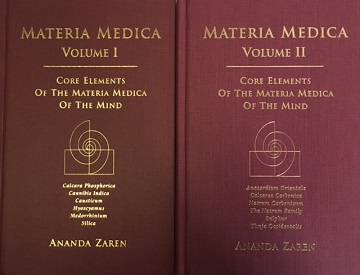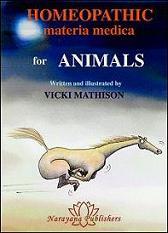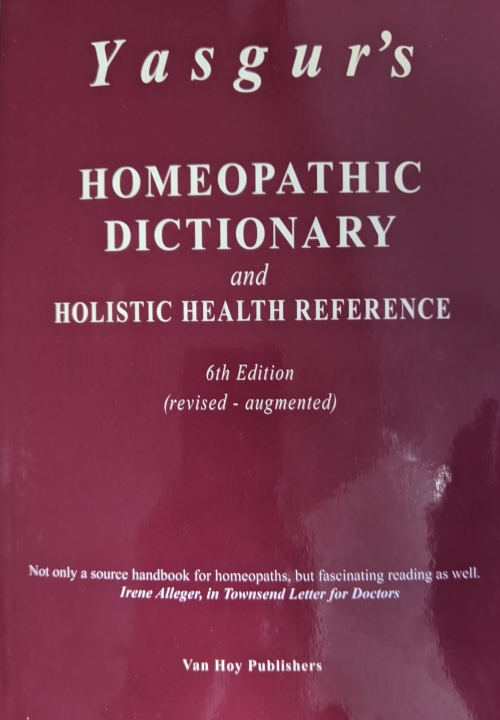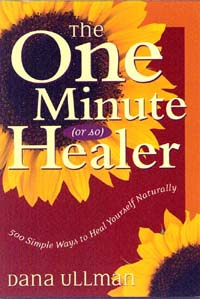Core Elements of the Materia Medica of the Mind by ANANDA ZAREN [#ZARMM]
$59.95
Description
Originally, these volumes sold for $70.00 each…but because we purchased them in bulk, we’re able to offer them as a set for a very special price of $59.95.
Although this 2-volume set is not a “new” book, they have only recently become re-available!
Ananda Zaren was an expert homeopath and a teacher of homeopathy as well as a teacher of teachers of homeopathy. Sadly, she passed away in 2008. She was an early student of George Vithoulkas, and she was a frequent lecturer in Germany where she lectured in hospitals.
Her chapter on “The Wound, The Wall, and The Mask” is a real classic in the homeopathic literature, and she used this simple but important insight into describing each remedy in her books.
This book review is reprinted from the British Homeopathic Journal Vol 85, Number 1, January 1996, with permission from Peter Fisher, Editor.
For Editorial communications, Advertising and Subscriptions contact:
British Homoeopathic Journal (now called “Homeopathy”)
Hahnemann House, 29 Park Street West, Luton, Bedfordshire LU1 3BE, UK
These two volumes of materia medica of the mind by Ananda Zaren offer a new model for exploring pathology and materia medica. The work has been influenced by Vithoulkas, and she emphasizes the importance of the emotional state in homoeopathic prescribing.
Zaren’s method of interpreting homoeopathic medicines and pathology looks at the initial trigger to the diseased state, which she calls ‘the wound’; the way the individual protects himself from further injury, called ‘the wall’; and the way the individual presents himself to the world, called ‘the mask’. Each medicine is analysed in this way.
These layers of presentation are akin to psychoanalytic theory, which views much pathology as linked to childhood trauma (the initiating wound), especially in the work of analysts like Alice Miller. Psychoanalysis also refers to the defences we develop to cope with this state (the wall), and discusses concepts like a ‘true’ and ‘false’ (i.e. masked) self.
Zaren asserts that when the individual is unable to cope with an injury or trauma, a wound is created. Commonly, this is caused by various forms of childhood abandonment. The features of the wound are that it is unexpected, and that its effects are deeply felt by the individual. This original wound is continually restimulated by repeated similar stress. In order to protect himself, the individual forms a barrier or ‘wall’ around the wound. This wall is represented by physical, mental and emotional symptoms presenting, which initially protect, but later disguise the original wound, causing it to fester underneath. The wall of symptoms acts to numb the individual’s response to the original offence and represents an adaptation to the trauma. However, the body becomes drained by having to maintain this defence.
Additional survival mechanisms are developed to obscure the wall, these the author refers to as the ‘mask’ or the ‘persona’, the interface the individual has with society. The mask serves to ‘distract the individual from the pain and loneliness of the true self’.
Homoeopathic treatment is aimed at matching the original wound plus the symptoms of the wall. Ananda Zaren sees the homoeopathic method as a painstaking method of working with the patient in order to uncover these layers of pathology.
The author discusses well-known medicines-Calc-p, Cann-i, Caust, Hyos, Med, Sil, Anac, Calc, Nat-c, Sulph and Thuja. However, her unique interpretation of the mental aspects offers new insights, also into pathology, in a similar way to the work of Catherine Coulter.
Each drug is explored with respect to aetiology, the wound, the wall, the mask, relationship issues, childhood presentations, and comparative materia medica.
A useful summary is provided at the end of each discussion, and ample references to rubrics in Kent’s Repertory are given throughout the discussions.
As with any materia medica of the mind, there is much room for interpretation, yet careful cross-referencing with Kent’s rubrics creates a convincing argument for the interpretations given.
I would recommend this book for in-depth study of the mental symptoms associated with the drugs. It provides a fascinating understanding of some which I thought I knew well!
TESSA KATZ
REVIEW OF VOLUME 2:
In the first chapter Ananda Zaren writes about the path of healing, describing the various stances the organism takes up to deal with trauma. This sensitively written introduction includes a section on ‘Characteristics of the Wound and resultant Walls in Children? The following chapters describe 5 remedies and the Natrum family.
“When trauma affects the body a pattern of disorganisation occurs that will require structural repair.. Therefore healing is actually a process of reorganisation”. The disorganised organism creates various mechanisms to deal with trauma wounding. “Avoidance mechanisms involve the tendency to shun new information as a strategy for moderating stress”. Such patterns are adopted to ” provide some control over an unpredictable environment …. remedies which tend to manifest avoiding behaviour include Cann-i; Carc; Staph; Calc Phos; Cocc; Thuja; …… Identification with the role of victim implies helplessness and a tendency to blame oneself for any misfortune. Remedies that fall into this pathological pattern include Nat carb. Sil; Staph; Puls; Carc; Arg Nit; ……
As healing progresses there will be an unfolding of Spiritual Awareness, the development of a value system and the ability to give and receive love.” I am really looking forward to reading the rest of this book.
The below review was published in LINKS and printed with permission:
Visiting her seminars and watching her interview patients on video there was always a kind of mystery about how Ananda focused the case. For me, and I think for most of the other students, it remained unclear until the end of the interviews, which of the many symptoms a patient uttered were the ones she would choose to prescribe upon. Many times Ananda tried to explain her strategy of case taking, but it was difficult to understand. Therefore I am sure that all her students appreciate that she has written down her ideas making it possible to follow her ideas pace by pace. In the first volume of her materia medica she presents her approach as follows:
In any case of deep pathology there is supposed to be a WOUND (physical abuse, emotional abuse, sexual abuse, violence, abandonment, neglect, etc.). This wound to the organism is not specific for any remedy, but it is nevertheless the cause of any pathological onset. The wound induces the vital force to react in a way that is specific for every individual, depending on constitutional factors and personal characteristics, creating a WALL to protect the wound from further injury. Therefore the symptoms of the wall are the guiding symptoms we have to focus the case upon, they are the symptoms we have to choose for repertorization and prescription. As a consequence, with every symptom we have to decide whether it belongs to the wall or the MASK. The mask being the image of the patient, the way he or she would like to appear, the “persona” of the Greek theatre. If we prescribe upon symptoms of the mask, our prescription will not penetrate to the deepest level of pathology and remain superficial. So if we want to go to the very core of the patient’s pathology, we have to learn to differentiate between the different layers of pathology. It is kind of like entering into the patient’s emotional sphere and looking from within outward, trying to understand how the vital force is acting. The set of our questions in the interview will start to be completely different if we adopt this point of view, and so will be the prescription.
The work of Ananda includes a couple of remedies and presenting their symptoms according to the connection to the wound, the wall or the mask. For all homoeopaths who would like to refine their skills in the direction of understanding and feeling the patients suffering and learn to prescribe on a deeper level, this materia medica approach will be of the greatest help. There is a real novelty of understanding and explanation of materia medica, which makes me look forward to the publication of her future volumes.
Ananda describes the wound the wall and the mask in the light of materia medica of six remedies; Calcarea phosphorica, Cannabis indica, Causticum, Hyoscyamus, Medorrhinum and Silicea. Anyone familiar with Ananda Zaren’s work will know that she brings new aspects to the materia medica. She suggests for example that the wound of Calc phos is from a physical violence and psychological bullying. The picture develops from the experiences of childhood where there may have been abuse. To protect themselves the Calc phos builds a wall of great sensitivity, helplessness, disassociation and grief and despair. Their mask is one of serenity and they appear sweet and mild.
After a discussion of the development of the wall, the wound and mask, Ananda then discusses the remedy in childhood and adolescence and the general theme is summarized giving rubrics related specifically to the wound, wall and mask. The chapter ends with a differential diagnosis.
There is a spiritual as well as practical element in this book which should appease even those who tend to shy away from the so called ‘spiritual’ element in homoeopathy. It is true that homoeopathy is a science, thus we have reliable provings, laws of cure etc., which help the homoeopath to understand and assess the treatment she is giving. The dimensions of a human being however, go beyond pre-defined concepts in their understanding. The idea of the wound the wall and the mask are one of the ways in which we can penetrate these dimensions. (Ed)
Homoeopathic Links – Fall 1993
Harry van der Zee MD (v.i.S.d.P)
Corrie Hiwat
P.O.Box 68
9750 AB Haren
Netherlands






Reviews
There are no reviews yet.